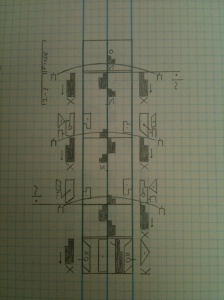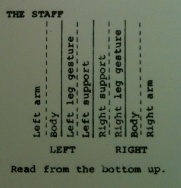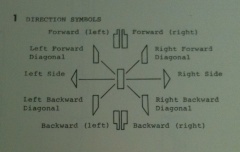The first week at the Dance Notation Bureau definitely flew by! It’s been amazing getting to know everyone in the office, especially Mei-Chen Lu, the Director of Library Services, and to jump right into the work. Mary Wegmann, a CLIR fellow working at the DNB for the summer, and I have begun physically arranging and rehousing the Research Files. We’ve made some great finds so far, which I will be sharing over the next couple of days.
But first, let’s discuss what this dance notation thing is. Don’t dancers just learn from teachers and choreographers, or from videos and films? Can you write dance? And even if you can, how can it accurately represent the physical and expressive qualities of dance?
Systems of notating dance (documenting dance on paper using symbols and words) date back to the early 18th century, but modern notation systems stem from Hungarian dancer and theorist Rudolf von Laban who published Labanotation in 1928. This system of notation creates scores that function for dance in the same way as music scores do for music. Scores are laid out in measures that correspond to the music measures and contain analysis of the movement, floor patterns, and information about motivations and nuances in the dance. Scores also include introductory information about the choreographer and dance composition, as well as costume, lighting, and scenic designs.
Labanotation describes the structure of movement by using geometric symbols placed on a vertical staff that represents the body. Here’s an example:
To read the score, start at the bottom and move to the top. The staff (seen below) is divided into sections that represent the sides of the body, with the center of the staff corresponding with the center of the body. Moving from this center out, the subdivided sections move from support to leg gestures to body to arm movements, for the both the right and left sides of the body.
The geometric shapes (seen below) represent movement forward, backward, sideways, and diagonally for the right and left sides.
Labanotation was brought to the United States by Ann Hutchinson Guest, Helen Priest Rogers, Eve Gentry, and Janey Price who organized the Dance Notation Bureau in 1940. The DNB is the only organization in the United States dedicated to the promotion, preservation, documentation, and study of human movement and dance through Labanotation. Its mission is “to ensure that theatrical dances can be performed in versions true to the choreographer’s artistic vision.” Paramount to the DNB is the preservation of dance legacies and the promotion of dance literacy through the teaching and use of Labanotation to record and stage choreographed dances.
The DNB Archives house scores of more than 780 dances by more than 270 choreographers, with 4 to 6 added each year. These dance scores are supplemented by music scores, production information, and CDs and DVDs of performances. These scores are used to stage dances across the country from choreographers like Paul Taylor, George Balanchine, Doris Humphrey, Jose Limon, and Martha Graham.
A 2011 staging of Doris Humphrey’s Water Study (1928), the most often checked out score from the DNB.
For more information about the DNB and their archives, check out their website. You can also learn more about Labanotation basics on the website! Also, make sure to check out the DNB’s Facebook page for the latest news, updates, links, and photographs from the office and archives!
-MEM





These scores are amazing! Started in 1928…are you telling me these are hand-written? Is there Labanotation “short-hand” for taking quick notes?
Hi Penny!! Ok, so it has taken me an obscenely long time to reply to you. The pictures I posted are of handwritten scores – and yes, until typewriting and computer programs were developed in the 1970s and 1980s, the scores were all handwritten. I know that notators still take notes by hand in rehearsals, but I’m not sure if they have a short-hand or anything. I do know that it’s like any language that once you know and get comfortable with it you can write it faster. Also, there are several other types of dance notation that are a little more short-hand-y, i.e. not as detailed as Labanotation. Hope that helps!! And that you’re doing well!! – Maureen